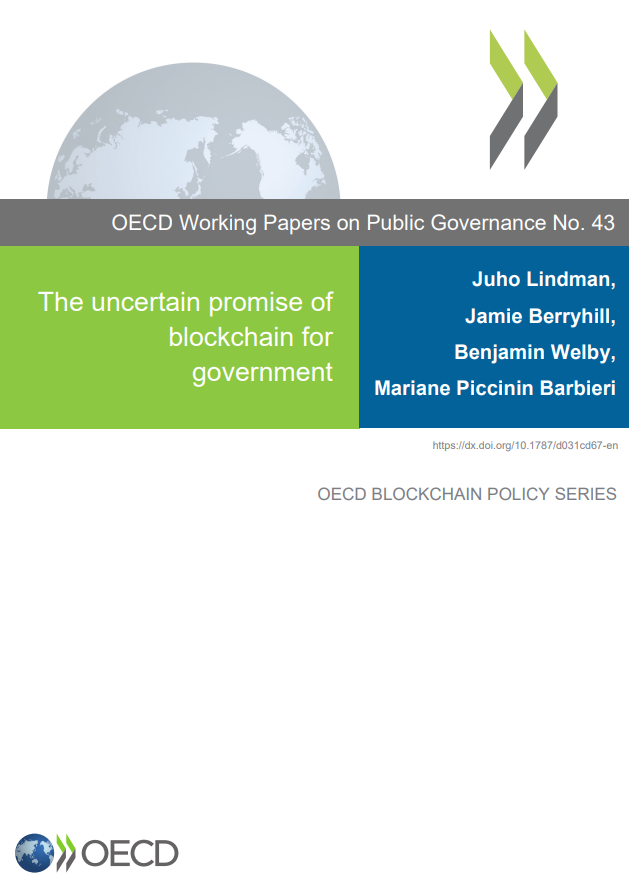The Uncertain Promise of Blockchain for Government

Summary
Blockchain and its underlying distributed ledger technology have the potential to fundamentally transform a wide range of industries and markets. However, so far, blockchain hype has often led public sector organisations to approach the technology with both uncertainty and unrealistic expectations, as such inflated expectations often overstate or obscure practical applications. Previous OECD work such as Blockchains Unchained: Blockchain Technology and its Use in the Public Sector and State of the Art in the Use of Emerging Technologies in the Public Sector have outlined the core blockchain technologies and their use cases and policy considerations for the public sector. Despite hundreds of pilots, there have been few government success stories related to blockchain implementation. Scepticism and cynicism are on the rise as this technology appears to be entering the proverbial “trough of disillusionment” common among emerging technologies as they inch towards maturity and a fuller understanding. This scepticism must be taken seriously and investigated in more detail to determine the extent to which it is warranted, and whether, when appropriate, it can be mitigated.
The OECD Observatory of Public Sector Innovation (OPSI) and the Digital Government and Data Unit have coordinated the development of this paper, which seeks to outline the current state of blockchain in government. It provides an overview of early projects, describes the observed beliefs and sentiment among the government actors, helps officials decide whether blockchain may be worth pursuing, debunks some commonly held misconceptions, and focuses on a set of examples and case studies that provide useful lessons and early observations about factors that have and can contribute to whether blockchain efforts are successful or unsuccessful, both at the project and organisational levels.
In doing so, the paper seeks to cut through the hype around blockchain, equip public sector decision makers with a better understanding of the current blockchain landscape, help officials take a critical look at potential use cases, and to assist them in their thinking as they consider, and if appropriate, initiate, manage, and de-risk blockchain technology projects. These steps can ultimately help future public sector blockchain implementations to succeed and reach their full potential.
This report is not an introduction to blockchain technology or its use in government. Despite aiming for a jargon-free report, readers are expected to understand the fundamentals of blockchain technology. Users who are interested in learning more about the technology can find overviews and guidance in the papers mentioned above. However, we recommend that the reader return to this report for an update after reading up on the fundamentals.
To aid in blockchain project success, this report explores the following questions and provides illustrative examples based on early reports and research:
- Is the blockchain solution viable, valuable, and vital for a particular service? (Chapter 1 Introduction)
- Does a decision maker have enough general knowledge and realistic expectations related to blockchain? (Chapter 2 Ten myths about blockchain in the public sector)
- Does the project take into account factors that lead to success and failure? (Chapter 3 Blockchain project success and non-success factors)
- Is the organisation digitally mature and blockchain-ready? (Chapter 4 Organisational and team success)
- Summary: How to drive a successful blockchain innovation project. (Chapter 5 Conclusion and recommendations)
Introduction
Chapter 1 provides an overview of the current situation and an overall framework to evaluate the benefits of blockchain services for a particular need using the three Vs (viable, valuable, and vital) checklist as applied to blockchain and associated use cases.
Ten myths about blockchain in the public sector
Chapter 2 lists common misconceptions and debunks commonly held myths about blockchains in the public sector to help the reader navigate this terrain. For instance, it dispels misconceptions that blockchains have served as a disruptive force in government, that blockchain can be applied as a general technology, and that users even care in general that a service uses blockchain.
Blockchain project success and non-success factors
Chapter 3 discusses factors underlying project success and non-success at the project level. For instance, research and OECD observations have identified a clear value proposal, a pre-determination that blockchain is the most appropriate technology for a task, and a focus on end users as success factors. Conversely, a high level of disruptiveness in an attempted project and an uncertain legal landscape are key contributors to projects falling short of expectations.
Organisational and team success
Chapter 4 approaches the suitability and implementation of blockchain to improve public sector policies, processes and services. The chapter starts by presenting the building blocks that help governments develop digital maturity to make good decisions about the use of a given technology. This chapter assesses how the digital maturity at organisational and at team levels influences the success, or otherwise, of blockchain enabled delivery of various services.
Conclusion and recommendations
Chapter 5 summarises the key findings of the report, and a series of appendices provide additional information. Appendix A focuses on case studies, including blockchain success stories as well as a discussion on problems projects have faced. Appendix B provides a longer list of potential use cases, focusing on projects that were able to proceed to the point where people began using the service.
Finally, it is important to note that the findings of this paper are based on early evidence and often—admittedly—anecdotal observations and analysis of successful and unsuccessful blockchain initiatives. Given the early nature of most government blockchain projects and the little amount of research focusing on public sector use cases, it is not yet possible to draw empirical evidence from a long list of uncontestably successful of failed public sector blockchain projects. However, the authors hope that this paper can serve as a step towards this goal

The Uncertain Promise of Blockchain for Government
Published on 16 November 2020.
